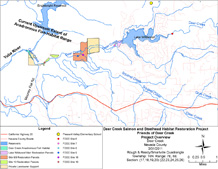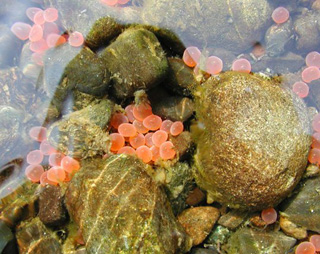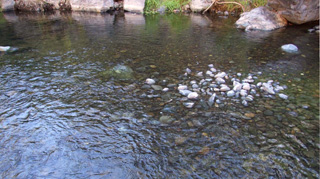
“Linking water,
science, and people”

Donate Now

Habitat restoration project map. Click map for larger image.
Salmon and Steelhead Habitat Restoration
Deer Creek is the last tributary on the Yuba before
upriver passage is blocked by Englebright Dam. Therefore, the mouth of Deer Creek at the
confluence with the Yuba River is a spawning ground for
Central Valley Chinook salmon and steelhead. Salmon and steelhead were present at
the mouth of Deer Creek in large numbers in the early part of the 20th century. Human
activity, including dams, development, agriculture, and water diversions, have
resulted in a decline in the amount of suitable spawning habitat. Sierra Streams is
engaged in longterm efforts to restore critical habitat through a combination of
approaches, including riparian native revegetation, targeted invasive species removal,
regularly repeated gravel injections, spawning bed enhancement, and modifications to
the management of the watershed. Our efforts are part of a regional effort to reverse
decades of steep decline in anadromous fish populations.
Salmon and steelhead require gravels of a specific size range in order to build their
spawning beds. These gravels are essential to the viability of the eggs, offering
protection and allowing for oxygenation of the water as it flows through the bed. In
the Deer Creek watershed, dams have altered the natural sediment transport and
deposition dynamics, which has led to the stretch of Deer Creek downstream of Lake
Wildwood being depleted of gravels of suitable size for spawning salmon to use. Adding
gravels will replicate the natural process currently interrupted by the dam. Sierra
Streams is currently implementing a Supplemental Environmental Project, funded by
Nevada County Sanitation District #1 in lieu of fines owed to the Central Valley
Regional Water Quality Control Board for violations at the Lake Wildwood Wastewater
Treatment plant. The funding has allowed us to complete the lengthy permitting
process, and to plan for a pilot gravel augmentation effort scheduled for August 2011.
Additional funding is being sought for further gravel injections and to develop an
annually repeateable plan to inject gravels harvested from Lake Wildwood during the
periodic dewatering: gravels that would naturally be transported to the spawning reach
but for the presence of Lake Wildwood dam.

Salmon eggs in a gravel spawning bed..
Photo courtesy of Alaska Flyfishing Online.
With funding from Bella Vista Foundation, Sierra Streams is applying for permits to
conduct improvements to the gravel composition in the spawning reach. Sierra Streams
scientists, along with scientists from UC Davis and CSU Sacramento, have observed
several areas that will be suitable for spawning activity with the addition of gravel
and the repositioning of large substrates that armor the creek bed in locations
otherwise suitable for spawning. Gravel placement will be carefully engineered to
create ideal spawning conditions for immediate colonization by salmon and for the
macroinvertebrates on which they feed. Concurrent upstream revegetation efforts will
ensure that water quality and temperature conditions are suitable for the salmon that
make use of the newly created beds. Once permitting is completed, the strategy is a
low-cost and high-yield approach that is easily repeatable on an annual basis.

Salmon spawning habitat in the confluence reach
of Deer Creek.
Revegetation is critical to the longterm success of habitat restoration efforts.
Sierra Streams has begun the long process of removing invasive non-native vegetation
from the creek vicinity and restoring native riparian and upland vegetation.
Reintroduction of native trees and shrubs will result in stream temperature
reductions, uptake of nutrients, water quality improvements, and a continual supply of
woody debris, an important habitat component.
The strategy is to target sites throughout the lower watershed, beginning at the most
upstream parcel, the Lake Wildwood dam spillway and weir, currently heavily infested
with Himalayan blackberry, black locust, and other invasives. Sierra Streams has
received funding for its revegetation work from Bella Vista Foundation and from the
National Fish and Wildlife Five Star Program.

Ongoing restoration and revegetation efforts at site 10.
Central to the mission of Sierra Streams is providing data to governmental
agencies that those agencies can use to guide policy. Data provided to Lake Wildwood Association Public
Works Department and Nevada Irrigation District guides our collaborative efforts to
ensure water quality and minimum flow compliance.
Sierra Streams scientists work closely with the Lake Wildwood Lake Committee and Public
Works Department to ensure that impacts to the downstream reach are minimized during
the periodic reservoir drawdown. Our long collaboration has resulted in modifications
to the reservoir management that protect the creek and its habitat.
Sierra Streams works with creekside landowners and managing agencies to implement
modifications to land use practices, including implementing erosion control measures
and keeping grazing animals out of the creek and riparian zone.

Water being released from Lake Wildwood during the annual drawdown.








